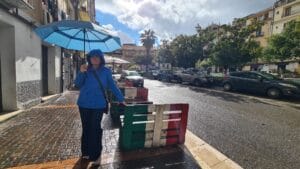
Lamezia Terme: The Blog That Nearly Didn’t Happen – By Andy
A2Z Wander | Our Blog A Rainy Arrival (and a Slight Hangover)Lamezia Terme almost didn’t get its own blog post. There’s only so many ways
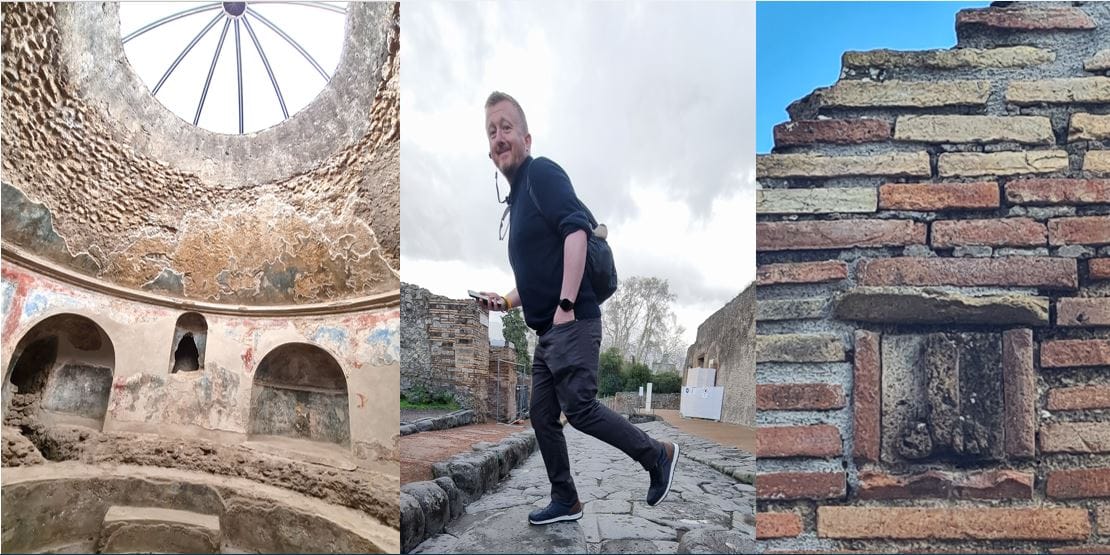
At the risk of sounding like one of the overly privileged, I learnt about Pompeii at school whilst struggling to learn Latin. However, I can remember very little of either the language or the history, so when we had the opportunity to visit I was keen to bring the place to life a good 30 years after I first heard of it.
And if you’ve ever wondered whether a 2,000-year-old city could still raise eyebrows, inappropriate giggles, and limp ankles—welcome to Pompeii.
We did it in two hours, a bit like trying to speed date an entire civilisation, but we gave it a good go. Our guide assured us you’d need at least three days to do the site properly. I barely made it through the first set of stepping stones without almost spraining something, I don’t fancy my chances over three days!
Today, this ancient city is eerily quiet, especially under grey skies, but in its heyday Pompeii was the place to be in Campania. Situated near the Bay of Naples, it benefited from fertile volcanic soil, access to trade routes, and a prime location for lounging about in togas and inventing indoor plumbing.
“Campania,” our guide explained, “means ‘fertile land’.” Looking around at the abundant wildflowers sprouting defiantly between broken columns and stones, it felt apt. Nature is fighting to reclaim Pompeii, one poppy at a time.
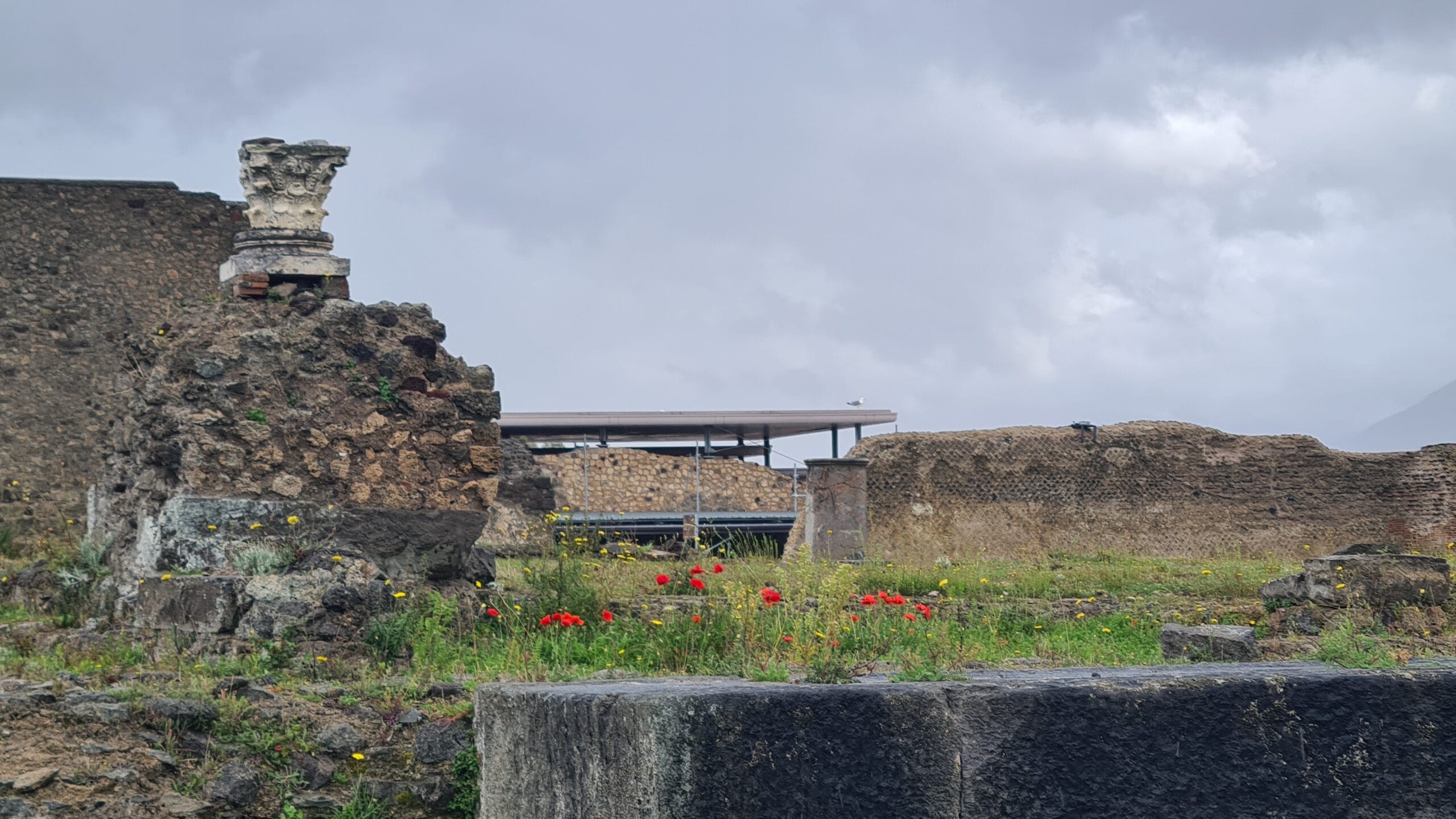
But it was that same fertile land—so generous in life—that would ultimately seal Pompeii’s fate. In AD 79, nearby volcano Mount Vesuvius erupted with devastating force (it’s estimated that it released 100,000 times the thermal energy of the Hiroshima-Nagasaki bombings), burying the city under a thick blanket of ash and pumice. What was once a vibrant Roman town was frozen in time within hours—preserved, strangely perfectly, by the very mountain that had made it prosper.
Vesuvius itself, cut in half by the eruption, still looms large over not only Pompeii but the bay of Naples. It is the only volcano on Europe’s mainland to have erupted in the last hundred years and is regarded as one of the most dangerous volcanoes in the world. Eruptions tend to be violent and explosive. 3 million people live near enough to be affected by an eruption, with at least 600,000 in the danger zone. This is the most densely populated volcanic region in the world.
We entered the site near Porta de Stabia, one of eight gates of the ancient city.
Our first excavated building was the Quadriportico dei teatri.
A courtyard surrounded by a portico, with small rooms coming off it. Our guide pointed to the small doors, “small people us Italians” he quipped, but something we would notice at other times in our trip.
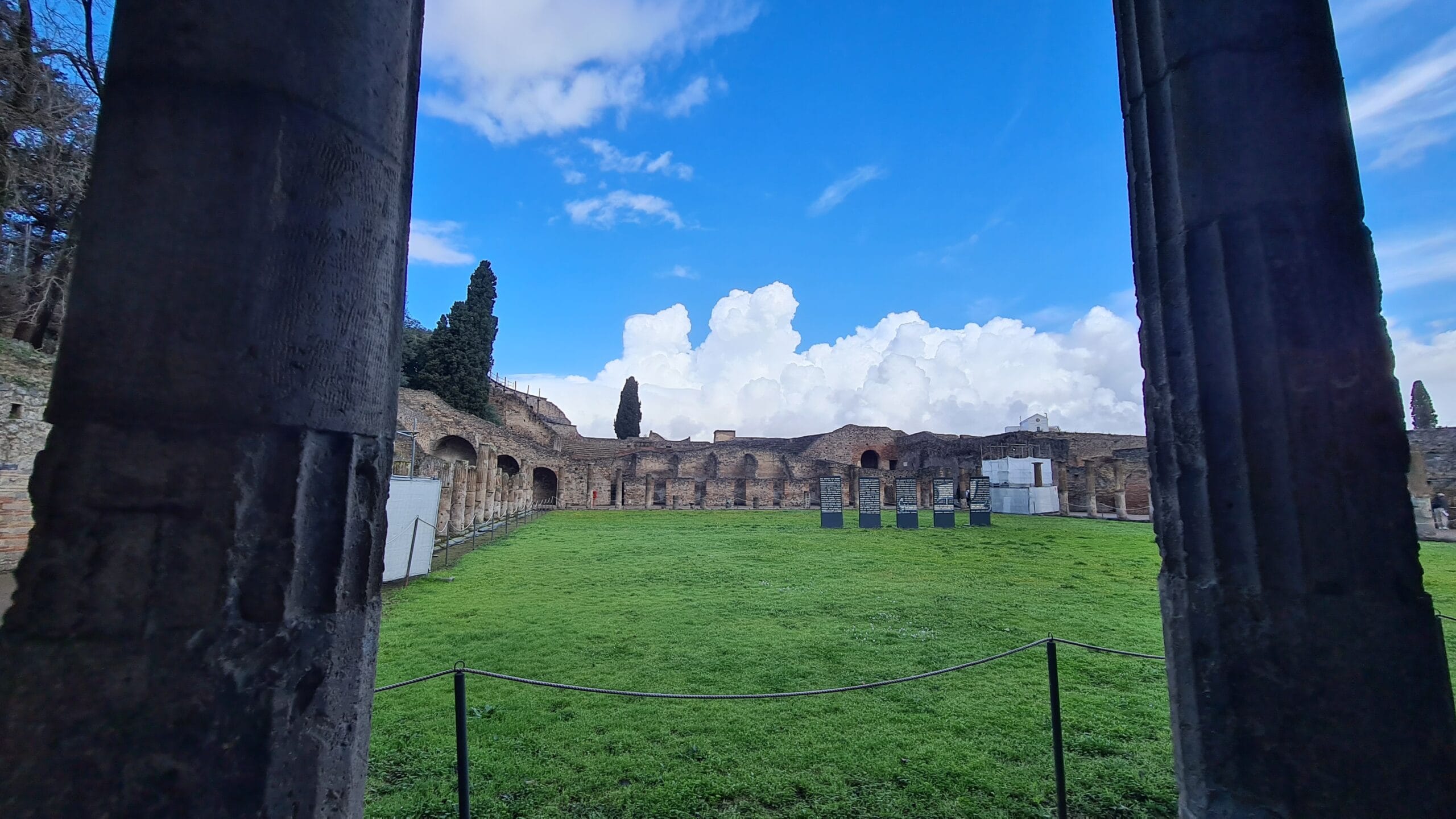
Originally the space acted as a foyer used by the adjoining theatres during production intermissions, the building changed purpose becoming a barracks for gladiators (the building is also called Caserma dei Gladiatori or Gladiator’s barracks).
Harrowingly, our guide told us that when the site was excavated one room had bodies chained to the wall. These prisoners left to perish have since been removed but a reminder that it was a simpler, more brutal time.
One of the most surreal moments came as we were in the theatre. Our guide, eyes twinkling, said: “Roman Dolby Surround Sound.” and he wasn’t joking.
Stand in the centre, say a word, and it echoes with eerie clarity, no need for microphones or fancy sound systems. Stand just a couple of feet from that point and the sound flattens.
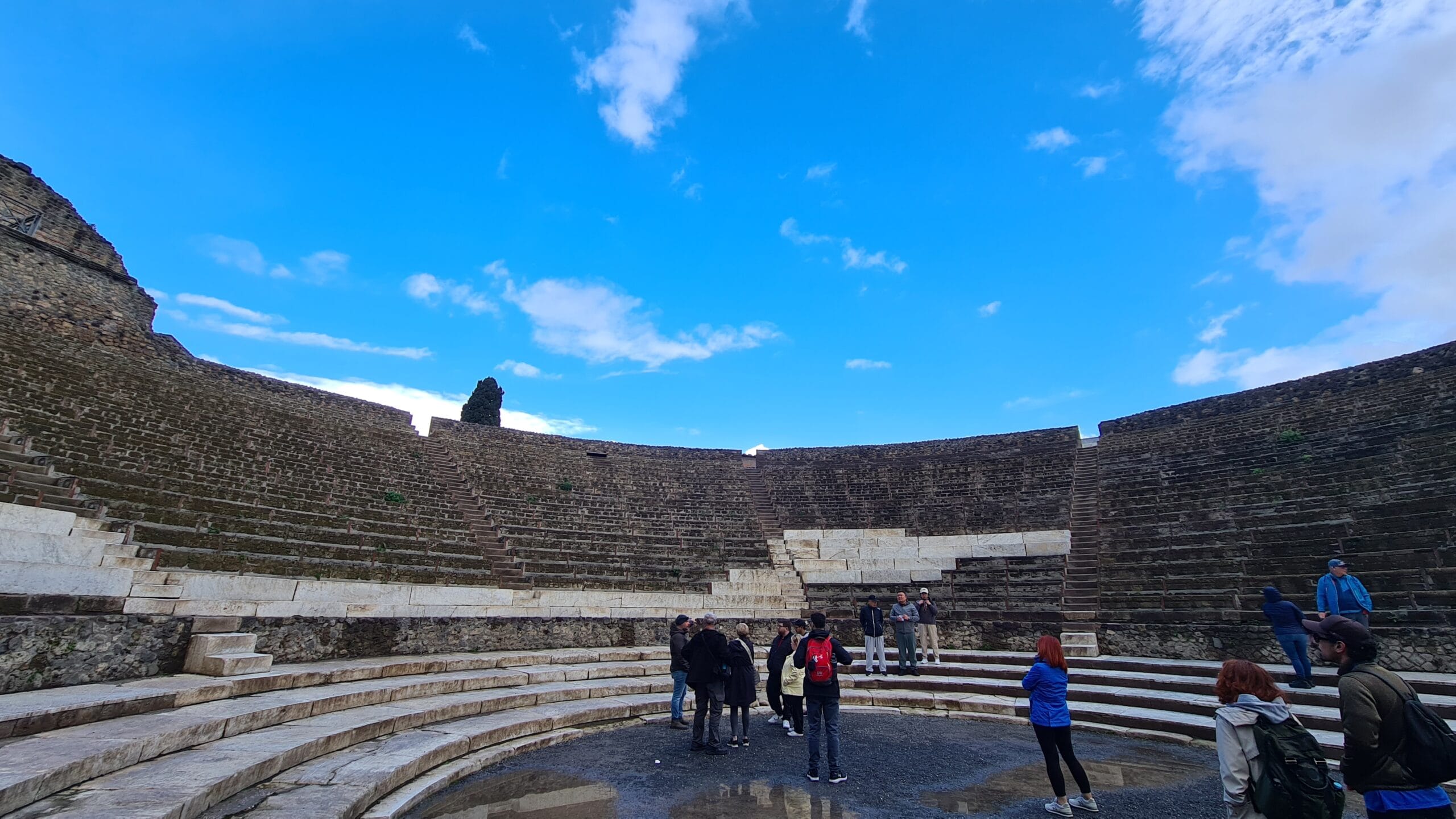
The theatre we stood in would hold close to 5,000 Pompeians enjoying comedies, mimes and pantomimes. Laughter would’ve echoed for streets.
As we moved from the theatre, right on cue came the first phallus. Graffiti on the wall leading from the Theatre into one of the main streets. It was not the last we saw.
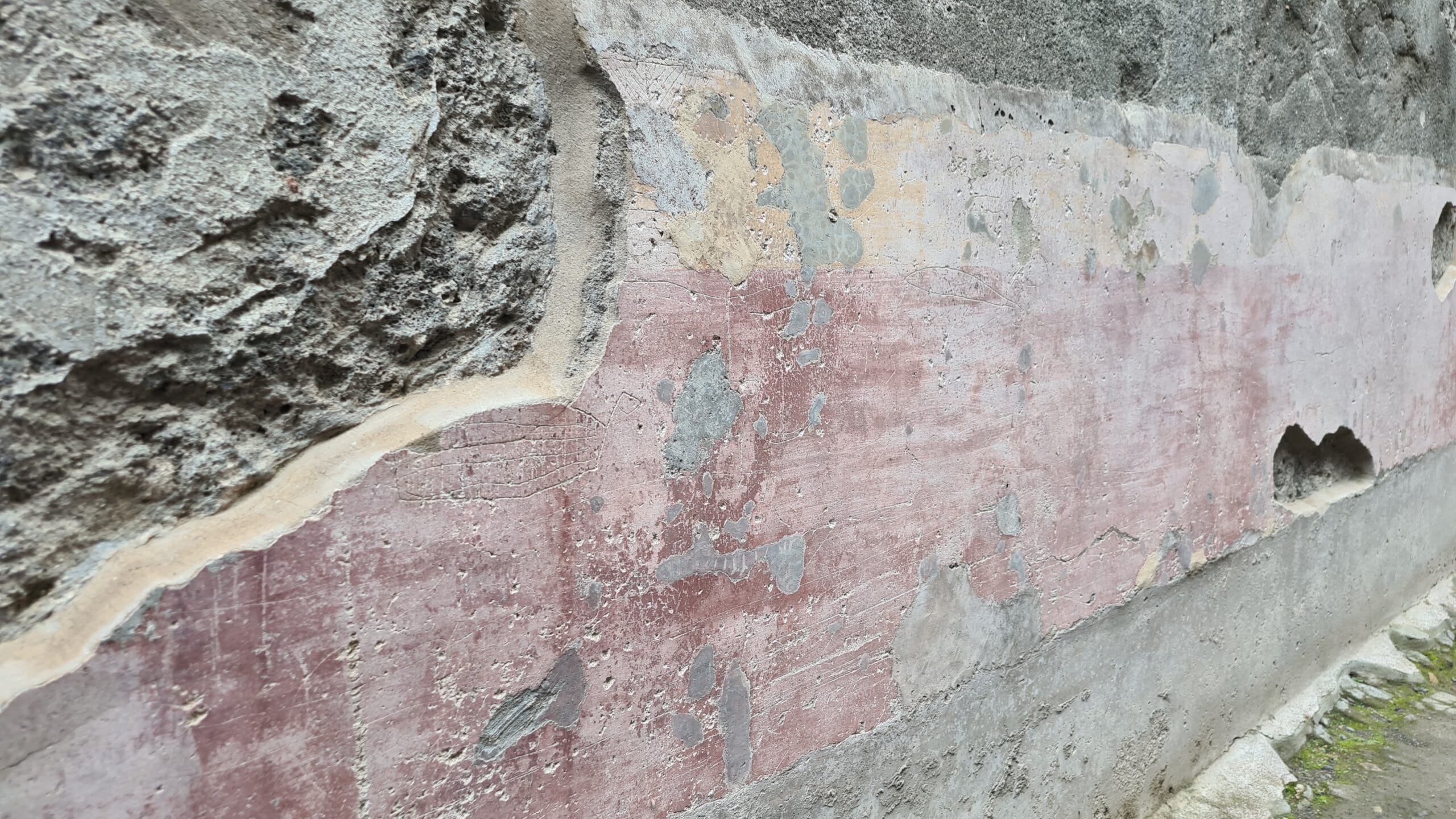
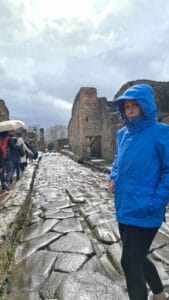 By this point in the tour, the rain had become a character in its own right. It turned the stone roads into slippery obstacle courses. At one point, trying to cross the road using the famous stepping stones (designed to keep feet dry above the filth of the streets), I misjudged the gap and came dangerously close to doing a dramatic pratfall worthy of a Roman tragedy. I somehow stayed upright, but my ankle was holding a grudge for a few days.
By this point in the tour, the rain had become a character in its own right. It turned the stone roads into slippery obstacle courses. At one point, trying to cross the road using the famous stepping stones (designed to keep feet dry above the filth of the streets), I misjudged the gap and came dangerously close to doing a dramatic pratfall worthy of a Roman tragedy. I somehow stayed upright, but my ankle was holding a grudge for a few days.
The stepping stones themselves are fascinating—high enough to stay out of the rain water and muck, but spaced so that chariot wheels could pass on either side. You can still see the deep ruts carved into the roads by traffic, frozen in time like scars across the city’s surface.
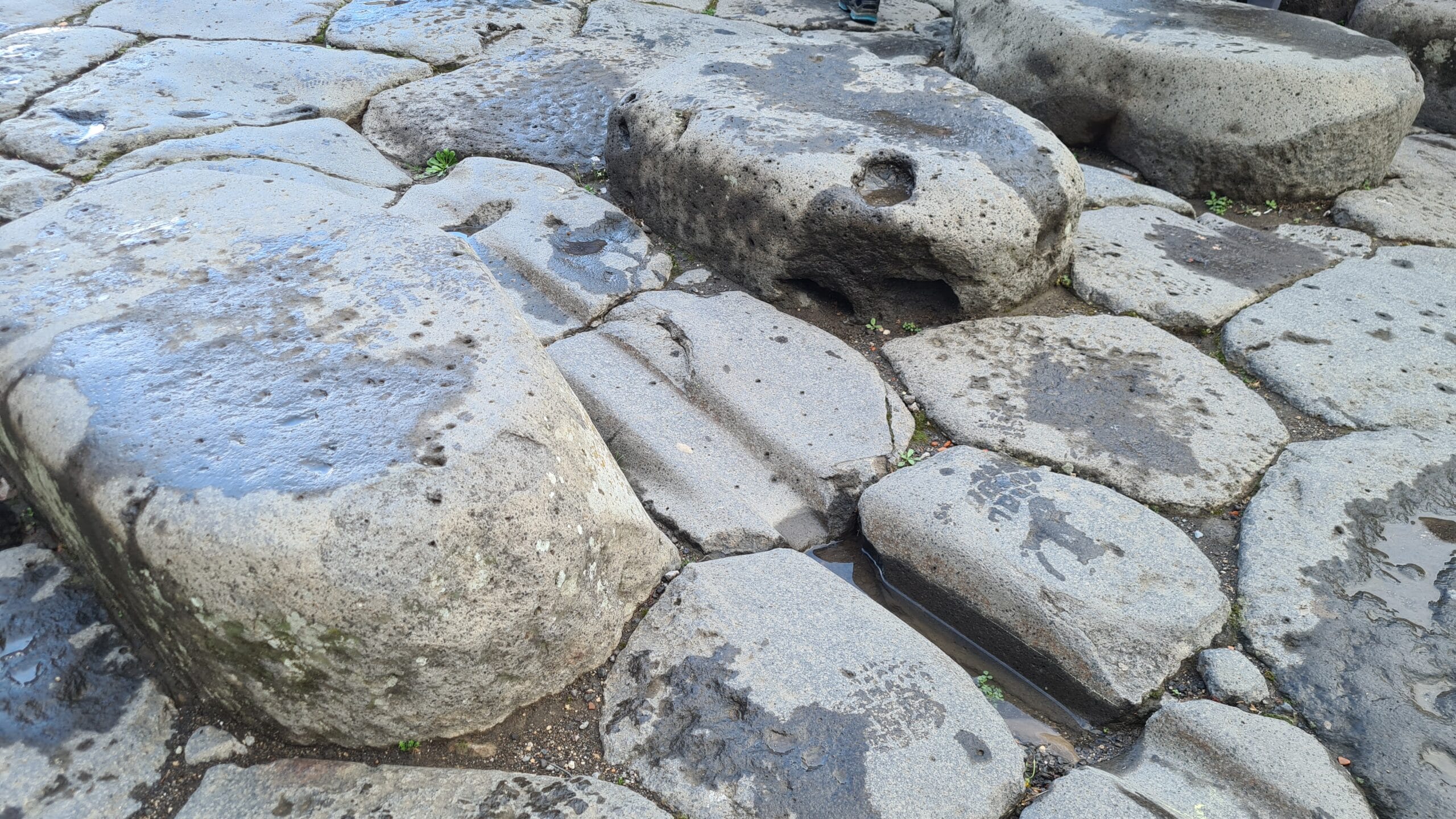
Our guide paused beside a public fountain, pointing out the carved head on its spout. “Different heads marked different neighbourhoods,” he explained. “People didn’t use addresses, they navigated by fountains and statues. Roman GPS.”
The fountains were more than decorative. They were part of an advanced water system that brought clean water into the city and helped flush out the streets—though given what it was likely flowing through, I’m not sure how clean is clean.
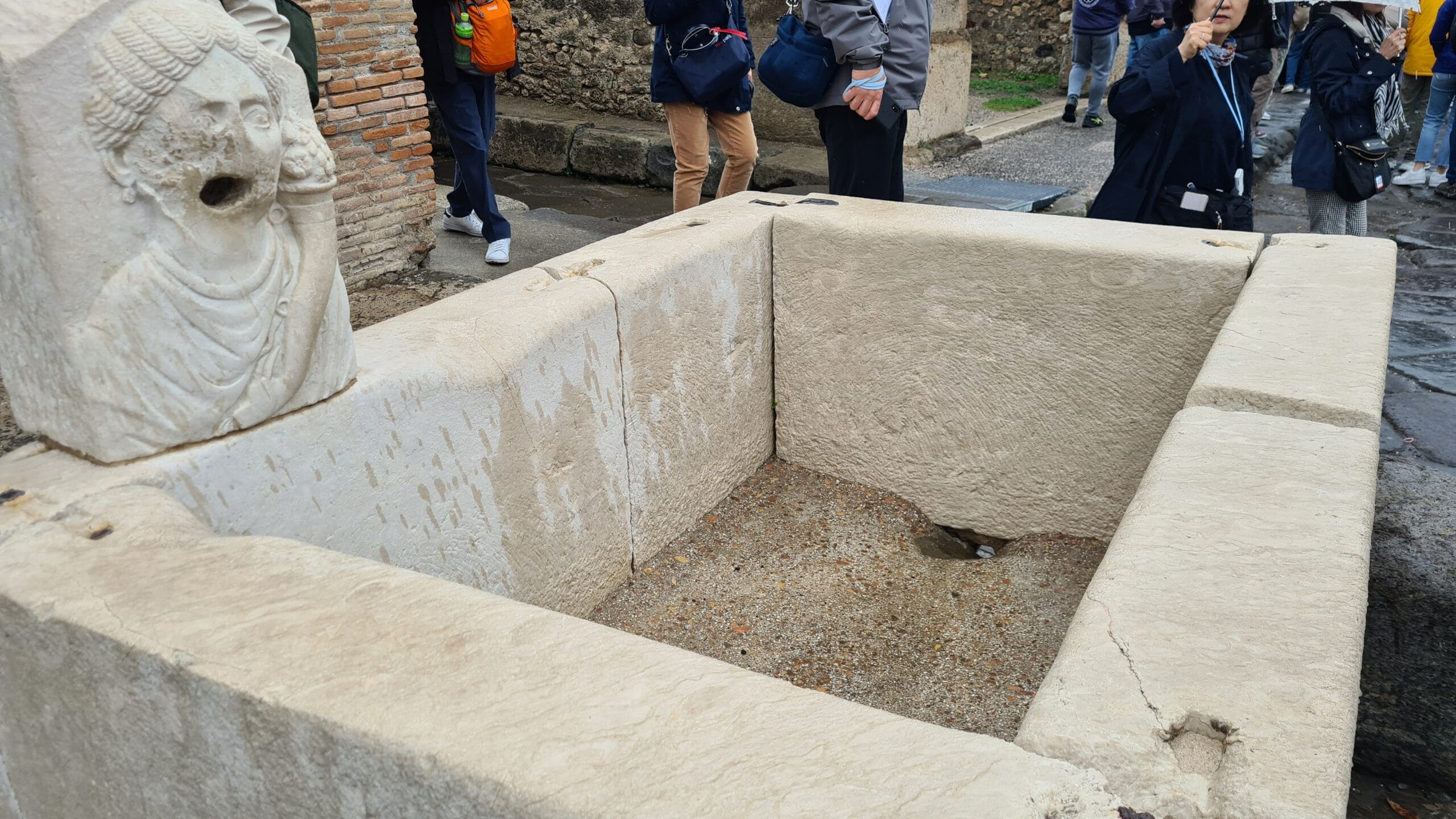
Pompeii was no backwater. Its wealth came from agriculture, trade, and wine production, and it had an impressive urban infrastructure to match. Water flowed through lead pipes, which, while advanced, may have inadvertently poisoned the population. Our guide noted that Roman men tended to live to around 40–45, women to 50–55.
Before Mount Vesuvius dramatically changed the course of history in 79 AD, Pompeii was a buzzing Roman city of around 11,000 to 15,000 residents. It had all the trappings of Roman civilisation—baths, temples, markets, theatres, aqueducts, and, crucially, takeaway joints. Nearly eighty of them. It seems, like us, the ancient Romans liked a bit of street food. Maybe a Mario equivalent would give visitors a food safari in ancient times.
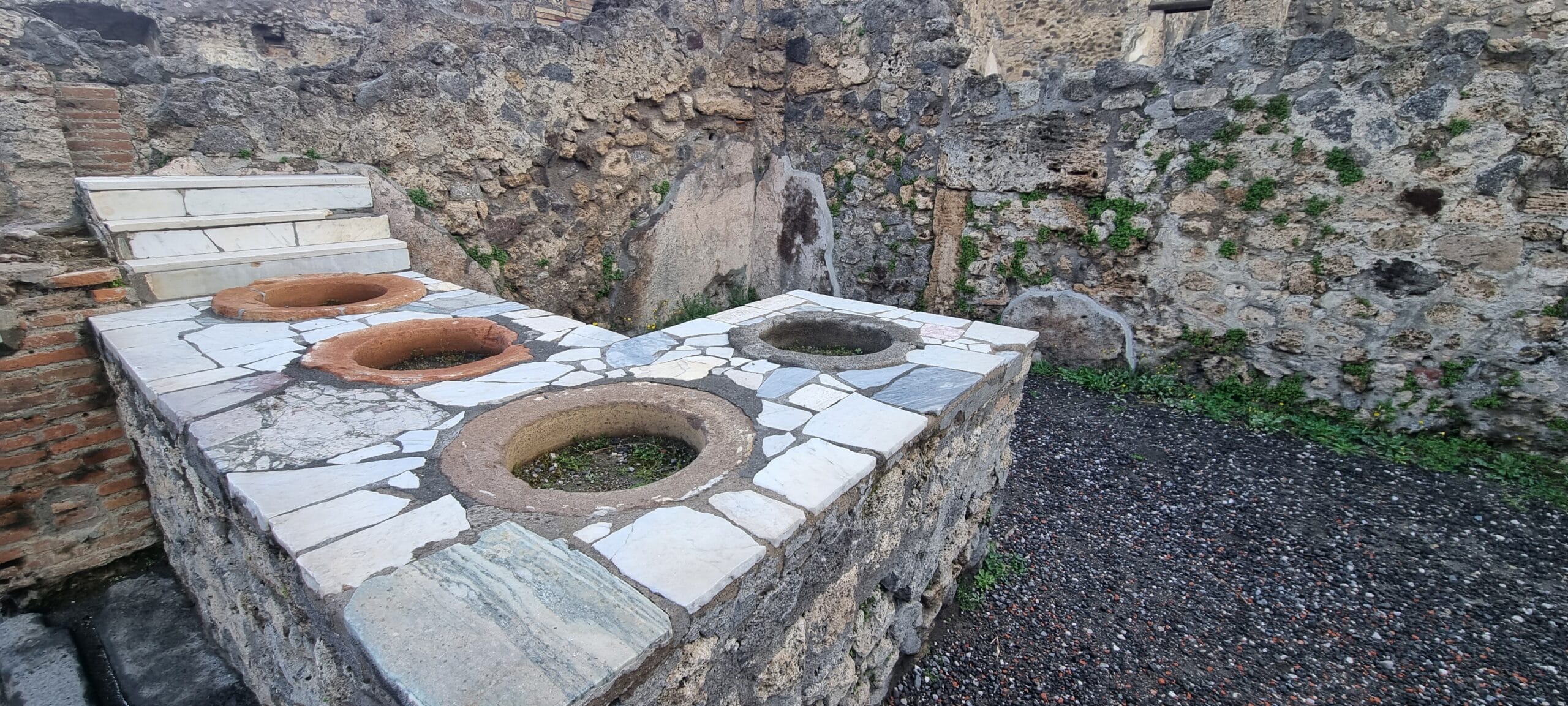
Pompeians had no shortage of places to grab a bite—there were over 30 bakeries, each with its own grinding stones and wood-fired ovens. Incredibly, some loaves were still in the oven when the ash fell. They remain today, blackened and whole, like time capsules crusted in carbon. The bakery we were shown even had a phallus symbol above the oven, blessing each and every loaf!
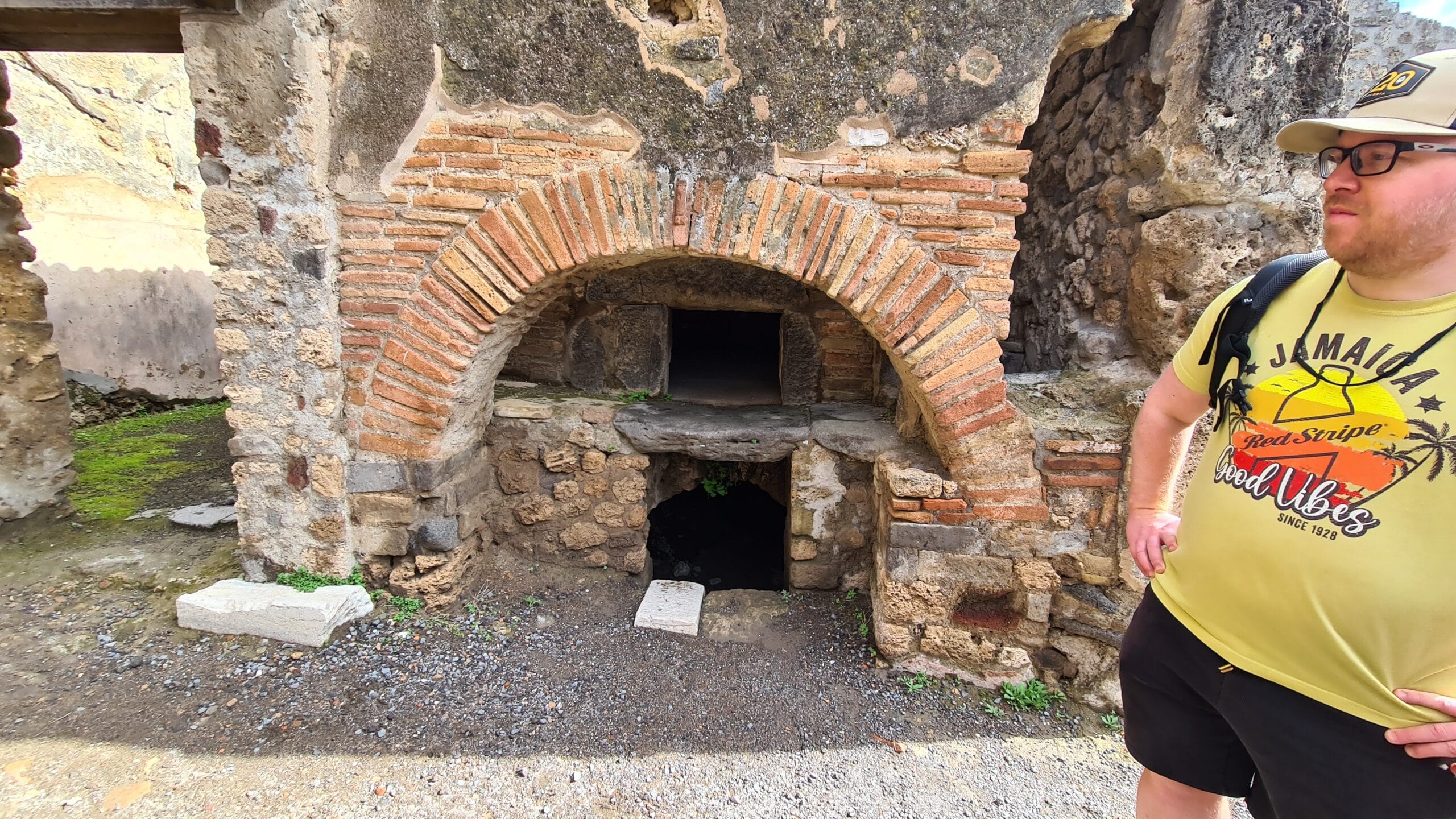
Today, Pompeii is quiet. But it’s not hard to imagine the energy of the theatre, the dust and heat in the streets, or the rivers running efficiently through the sloped roads during a deluge. The lives lived here were loud, passionate, and complex. Not just victims of a disaster, but real people with daily routines, gossip, ambitions, and a slightly unhealthy obsession with erotic carvings.
Pompeii wasn’t just efficient—it was indulgent. The public bathhouses were not only a place to wash but also the social hub of the city. Think of them as wellness centres with added gossip, gambling, and the odd brawl.
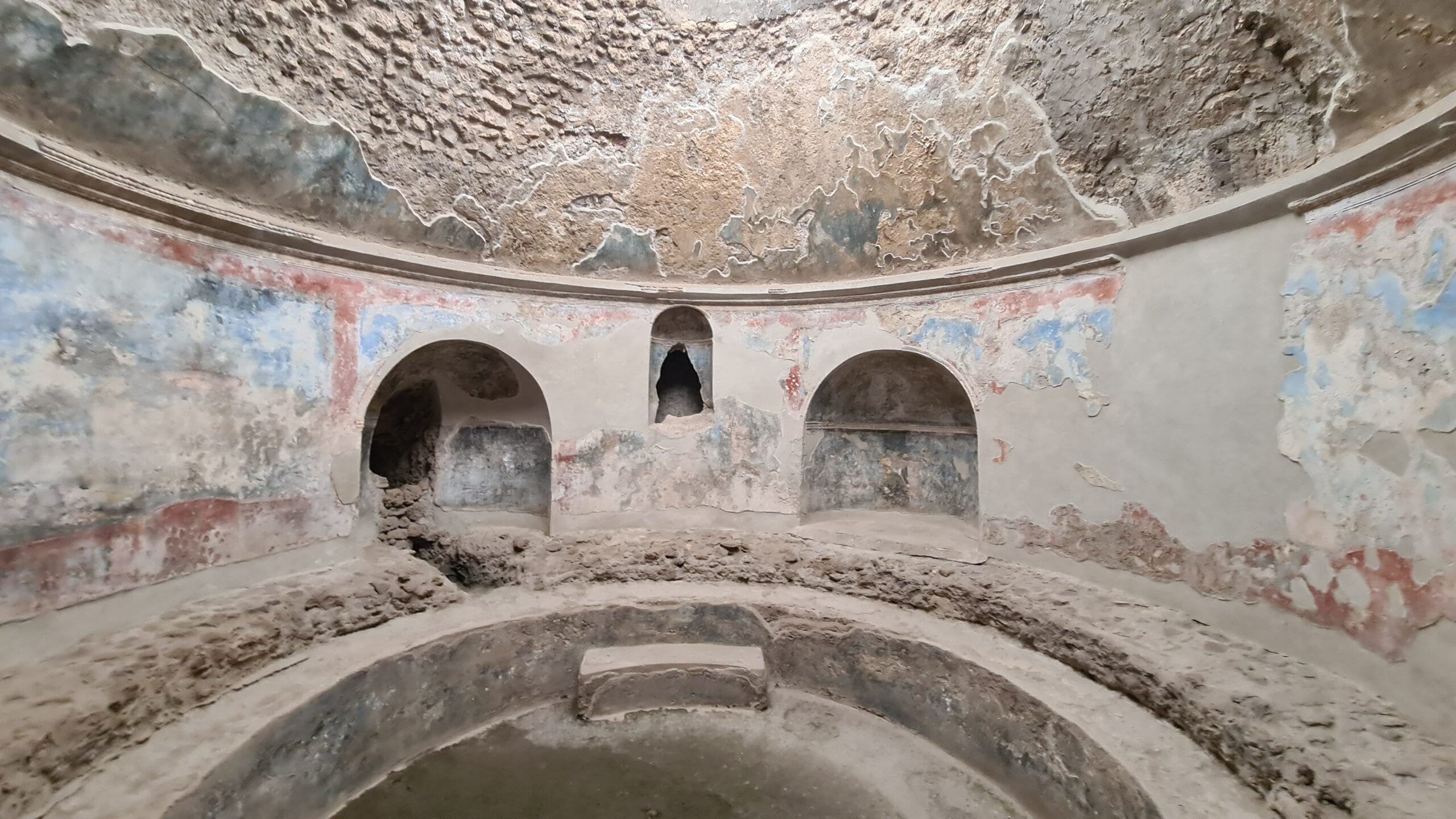
We visited the Stabian Baths. Tucked just off Via dell’Abbondanza, the main drag of ancient Pompeii, these are the oldest known public baths in the city, dating back to the 2nd century BC. Remarkably well-preserved, they offer a fascinating glimpse into Roman daily life, not to mention their engineering genius.
The layout was classic Roman: patrons began in the apodyterium (changing room), then moved to the tepidarium (warm room), the caldarium (hot bath with a rather glorious domed ceiling), and finally cooled off in the frigidarium. The baths even had a palestra—a courtyard space where bathers could warm up with a bit of wrestling or discus-throwing before soaking their troubles away.
The engineering here is fascinating. An underfloor heating system, called a hypocaust, channelled hot air through empty spaces beneath the floor and inside the walls, creating toasty rooms before central heating was even a twinkle in anyone’s aqueduct. The domed ceilings allowed the steam to cool and the water ran down to guttering, recycling into the system.
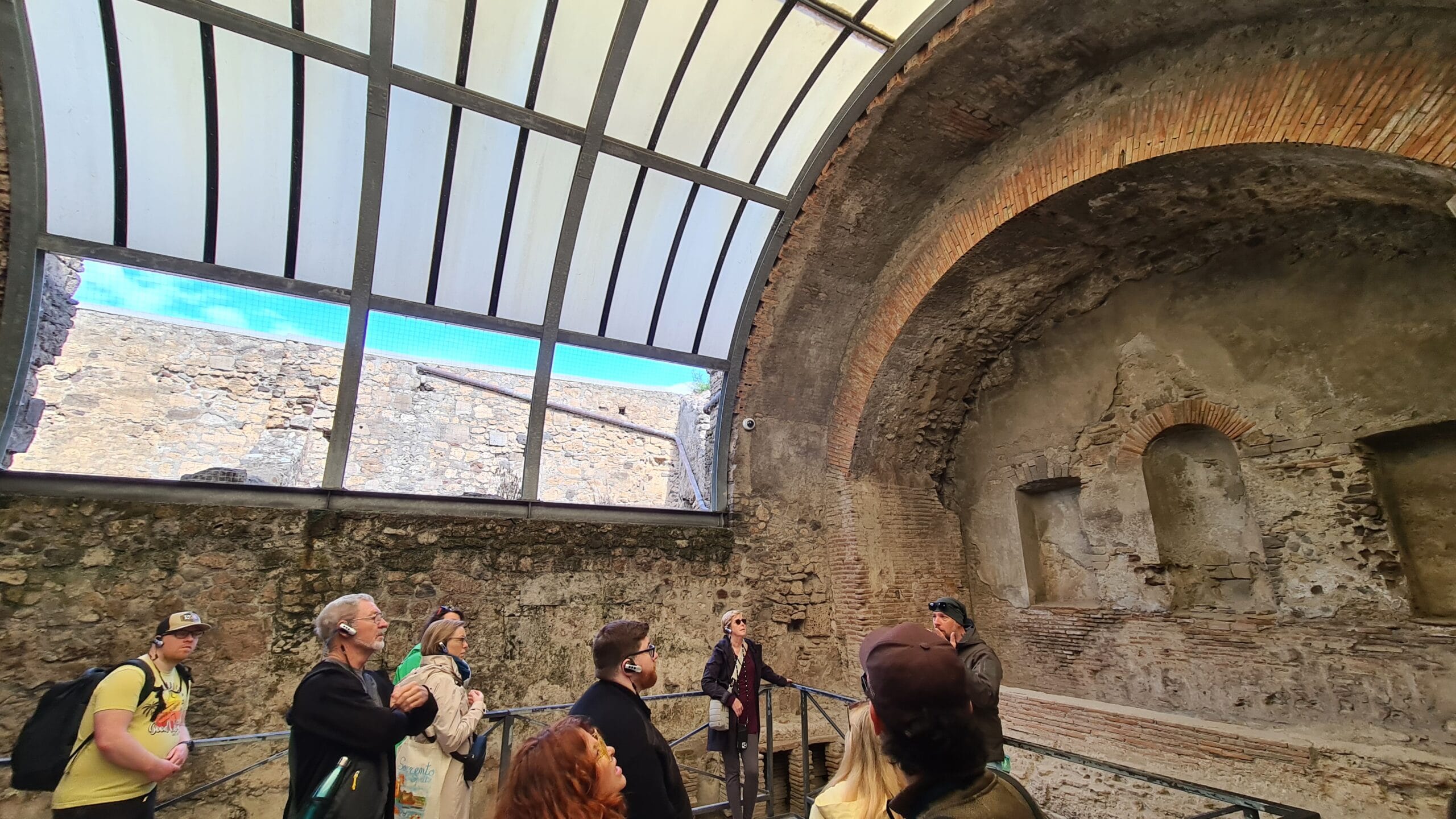
Water flowed in via pipes, and beautiful frescoes and mosaics adorned the walls, because why not enjoy a bit of mythology while sweating it out in a steam room? The Stabian Baths were more than functional—they were cultural melting pots. People of all backgrounds came here to bathe, chat, do business, or just see who was in town. In short, it was the ancient Roman version of a spa day and a networking event rolled into one.
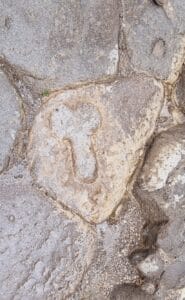 But not all Roman indulgence was scented with oils and steam. A short walk away, another side of Pompeii’s pleasures came into view, the lupanare (the official brothel of Pompeii).
But not all Roman indulgence was scented with oils and steam. A short walk away, another side of Pompeii’s pleasures came into view, the lupanare (the official brothel of Pompeii).
Carved into the pavement outside the baths, pointing unmistakably in the direction of the lupanare the “good luck symbol”. Our guide explained with a straight face, “also used for directions. Like a signpost to the red light district in Amsterdam.”
At the brothel, our guide delighted in pointing out the illustrated menu. Above the doorways, explicit scenes offered a visual preview of the services available, a menu of sorts.
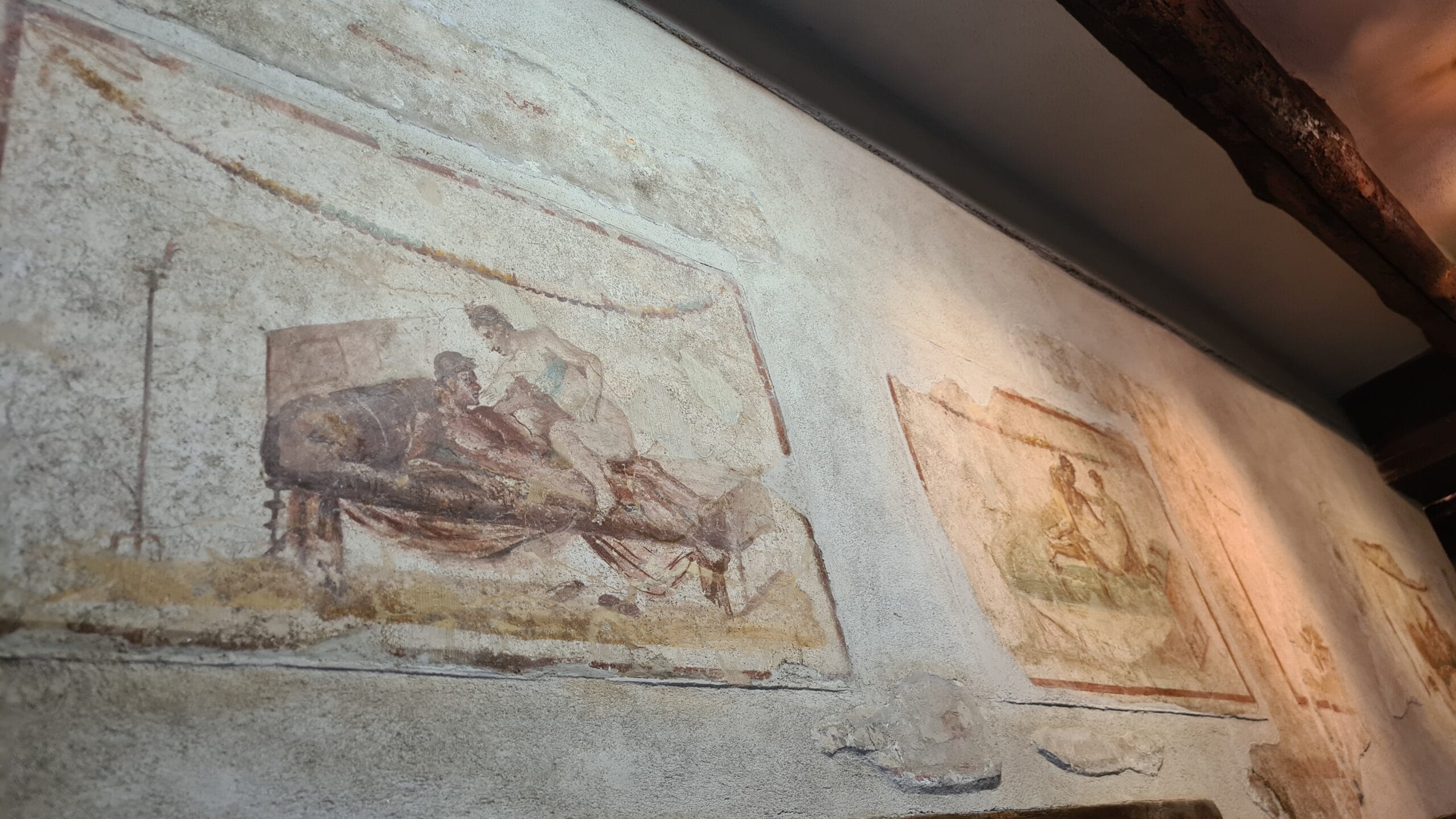
The phallic symbols around the brothel are numerous—sculpted into doorframes, etched into pavements, and in ancient times would’ve even been present in wind chimes.
Apparently, the ancient Romans associated the phallus with fertility, strength, and protection. It was a sort of multi-purpose good luck charm. In places like bakeries or taverns, a prominently displayed phallus might signal the owner’s desire for profitable trade and safe dealings—a bit like hanging a horseshoe above the door today. For the modern visitor, though, it tends to induce giggling and the awkward shuffling of school groups.
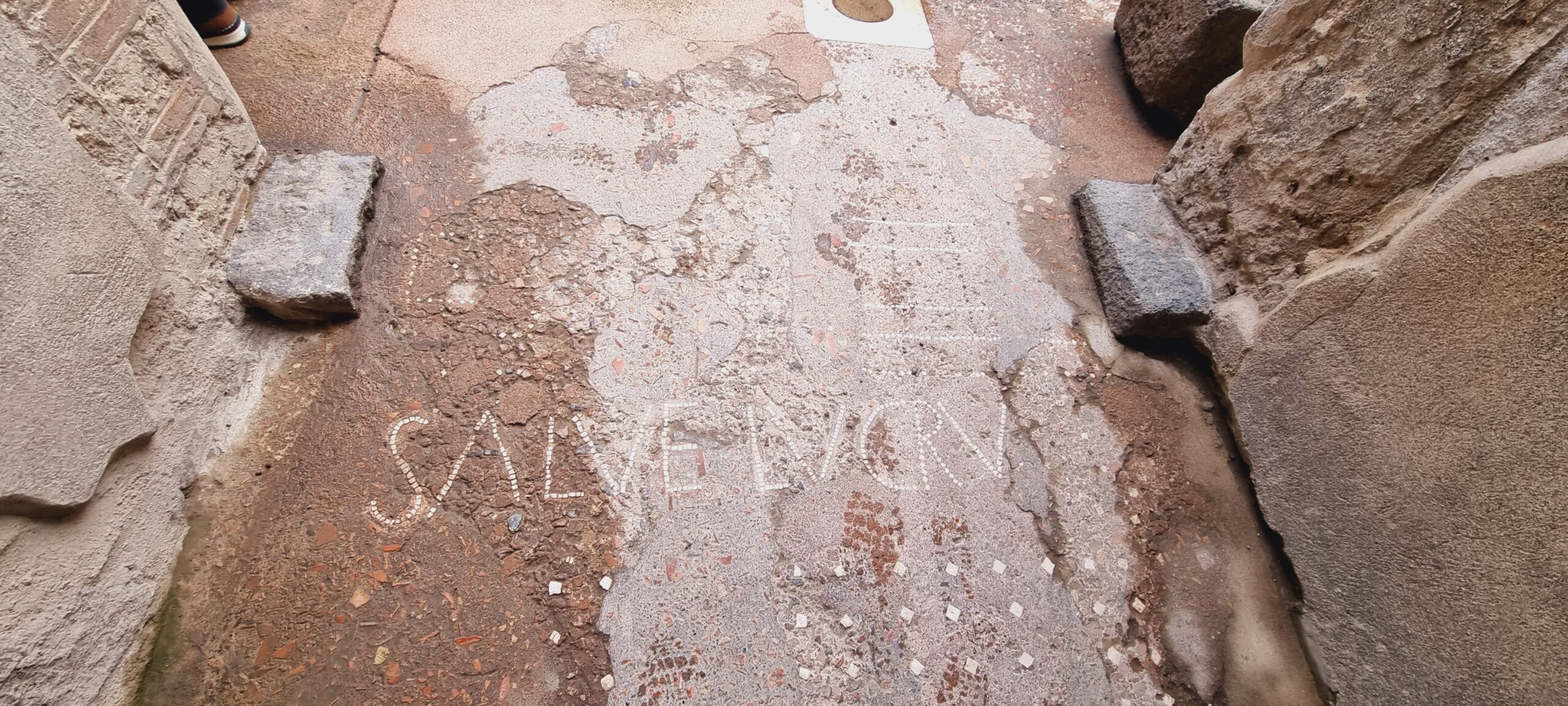
Tucked between Via Stabiana and Vicolo del Lupanare (the street housing the brothel), the Domus of Sirico is one of Pompeii’s more colourful residences—both literally and figuratively. This grand house belonged to a wealthy member of Pompeii’s political and commercial elite, likely someone who didn’t shy away from flaunting their fortune. In fact, visitors were greeted at the door with the cheerful mosaic message: “Salve Lucru”—“Hail, profit!” (subtle, it was not).
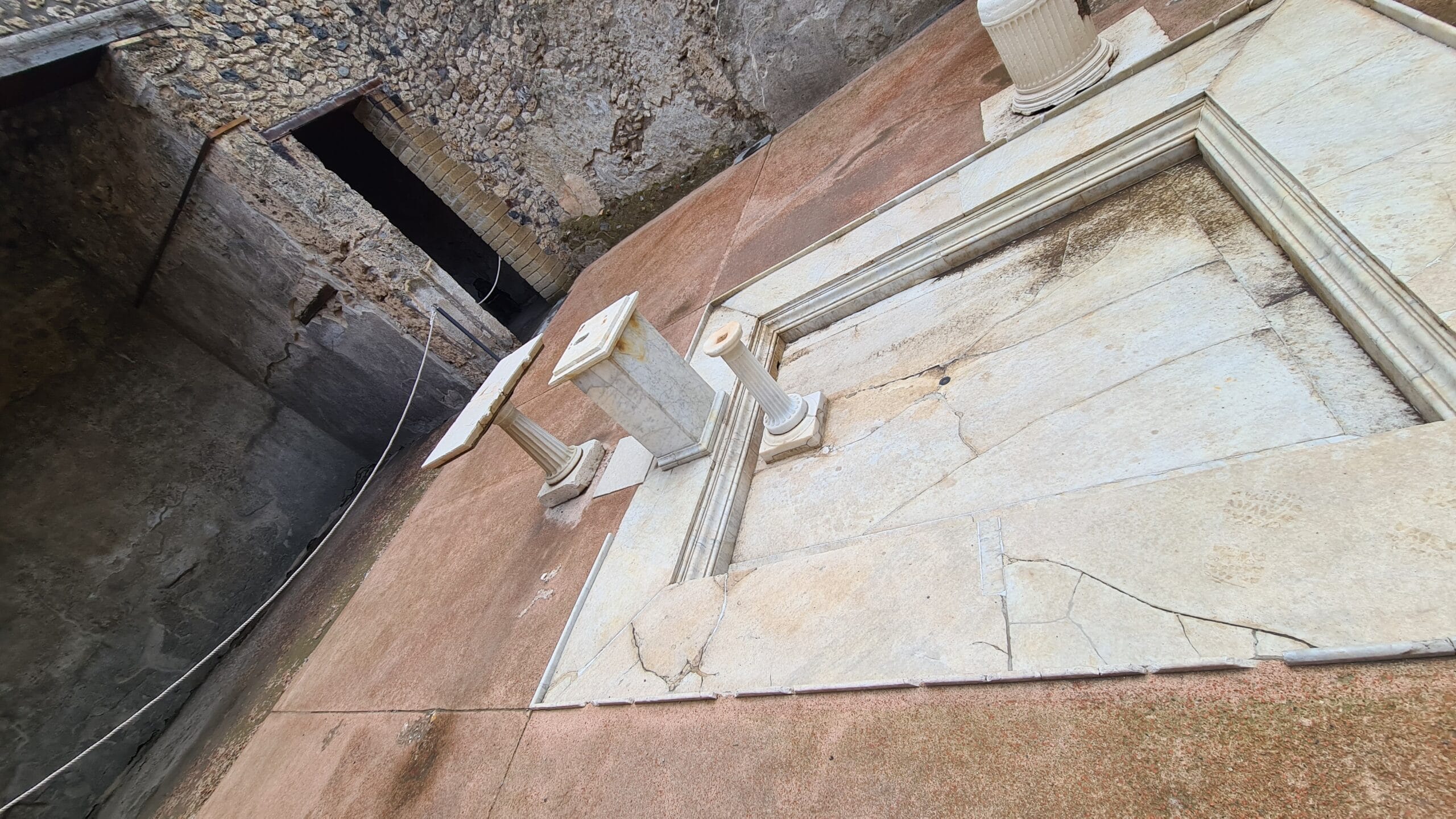
The house was unearthed in the mid-19th century and is a bit of a mash-up—two properties merged into one, possibly mid-renovation when Vesuvius erupted. It sits right next to the Stabian Baths, making it prime real estate for both relaxing and schmoozing.
But it’s the artwork that really sets the place apart. The Exedra room contains some standout frescoes still impressively preserved, featuring mythological heavyweights like:
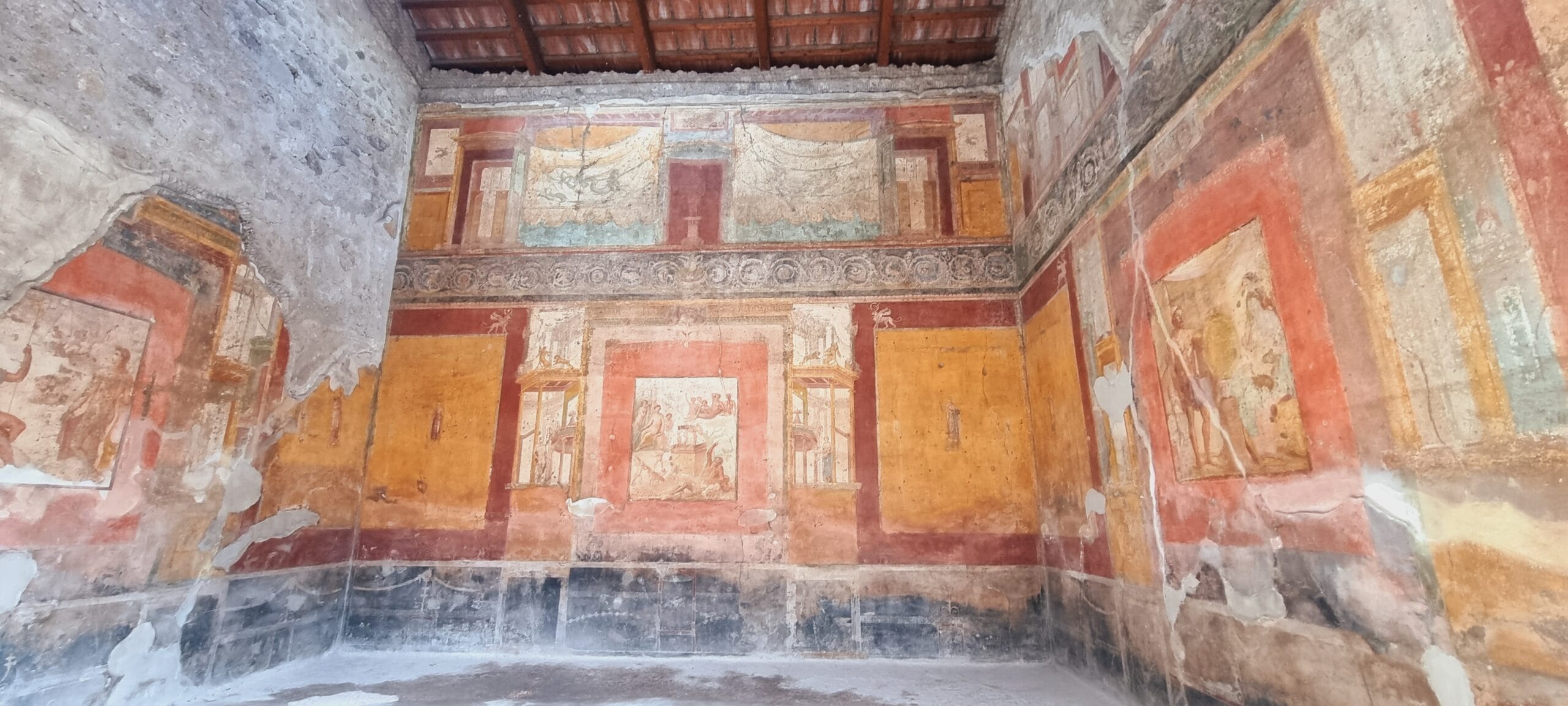
The Domus of Sirico offers a vivid glimpse into the lifestyle of Pompeii’s upper crust—equal parts ambition, myth, and mosaic. A must-see for anyone who enjoys ancient art with a dash of humour and a nod to commerce.
When Mount Vesuvius erupted in 79 AD, it sent a cloud of ash, pumice, and toxic gas hurtling into the sky. Pompeii was buried in just a few hours. Unlike neighbouring Herculaneum, which was hit by a pyroclastic flow that vaporised most of its residents, Pompeii’s victims were encased in ash, preserving the final moments of their lives in heartbreaking detail.
Plaster casts made from the voids left by decomposed bodies show people frozen in time—cowering, shielding loved ones, even clutching their pets. It’s sobering and oddly intimate. You’re not just walking through ruins—you’re walking through someone’s yesterday.
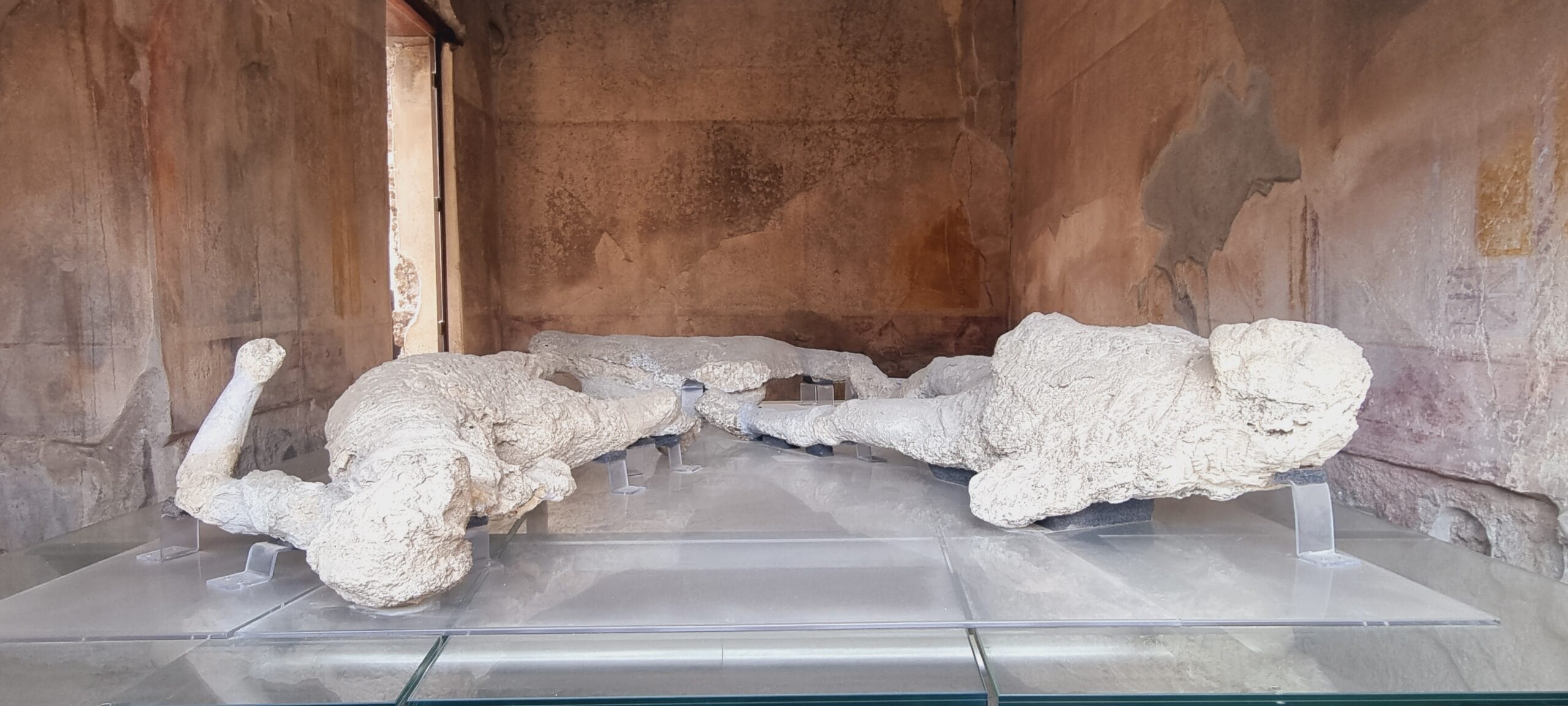
In Domus Sirici we saw the first of these haunting casts. Apparently a family caught in the ash cloud in a nearby alleyway, a father leading the charge, a mother clutching a few belongings and between them two small girls. A sad and tragic scene.
At the heart of ancient Pompeii stood the Forum—part marketplace, part courtroom, part temple complex, and all-round hub of city life. Think of it as the Roman equivalent of a town square crossed with Westminster, a farmers’ market, and a place of worship, all in one gloriously busy open space.
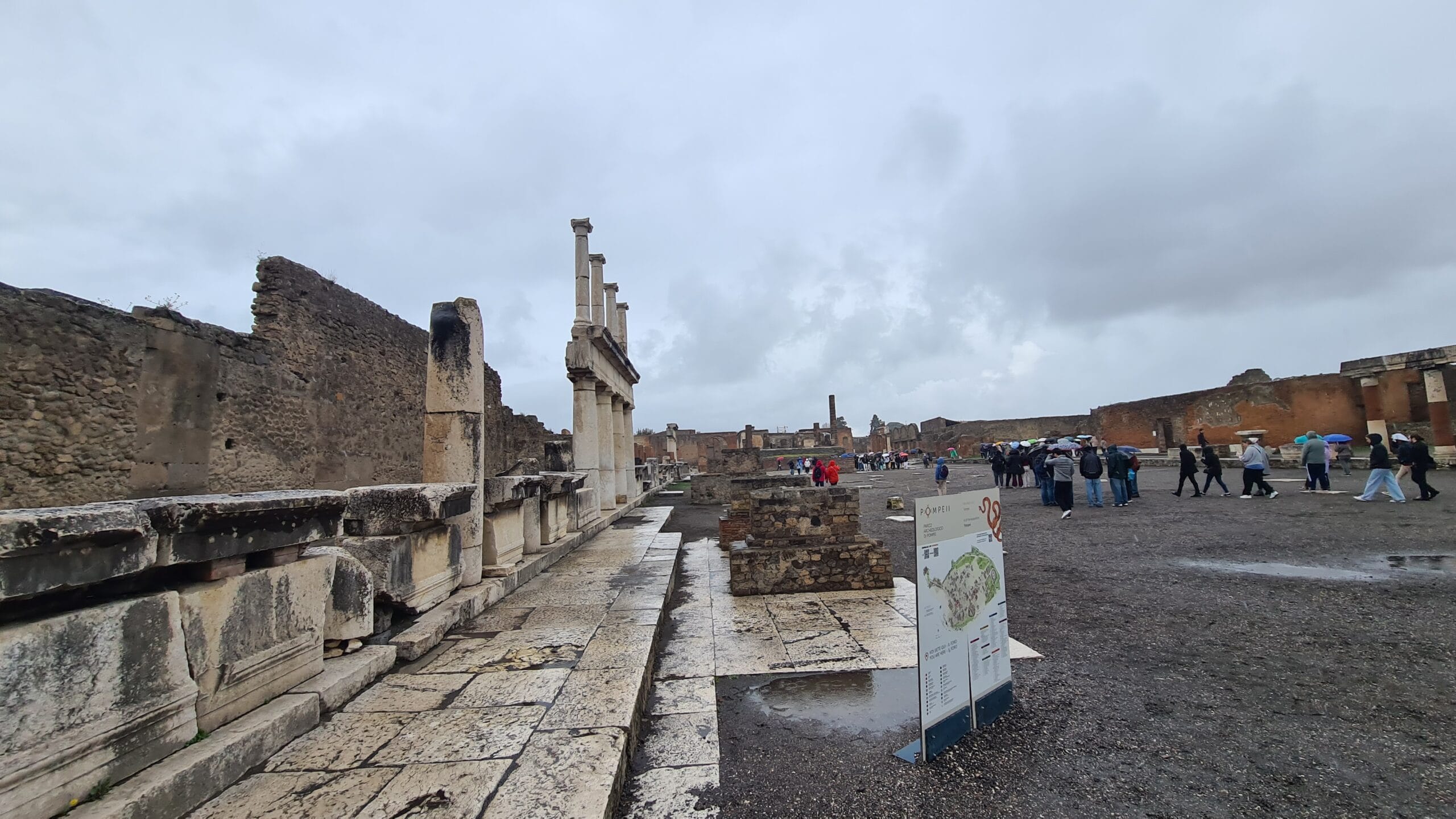
Surrounded by grand buildings like the Temple of Apollo, the Temple of Jupiter, and the Basilica, this was where people came to worship, wheel and deal, settle legal disputes, or just catch up on the latest gossip (of which, one suspects, there was plenty).
Back in the 4th century BC, the square was a bit more rustic—just beaten earth underfoot and scattered tabernae (shop stalls) doing brisk business. But by the 2nd century BC, the Romans got serious: the Forum was redefined, paved with concrete and volcanic tuff, and wrapped in elegant porticoes. Later, in full Imperial style, they upgraded to sleek travertine slabs.
Sadly, after the eruption in AD 79, the Forum was stripped of its decorations. But walk through it today, and you can still feel the buzz—the clatter of sandals, the echo of debates, the scent of market fare. It was Pompeii’s beating heart, and it still tells a story, if you listen closely enough.
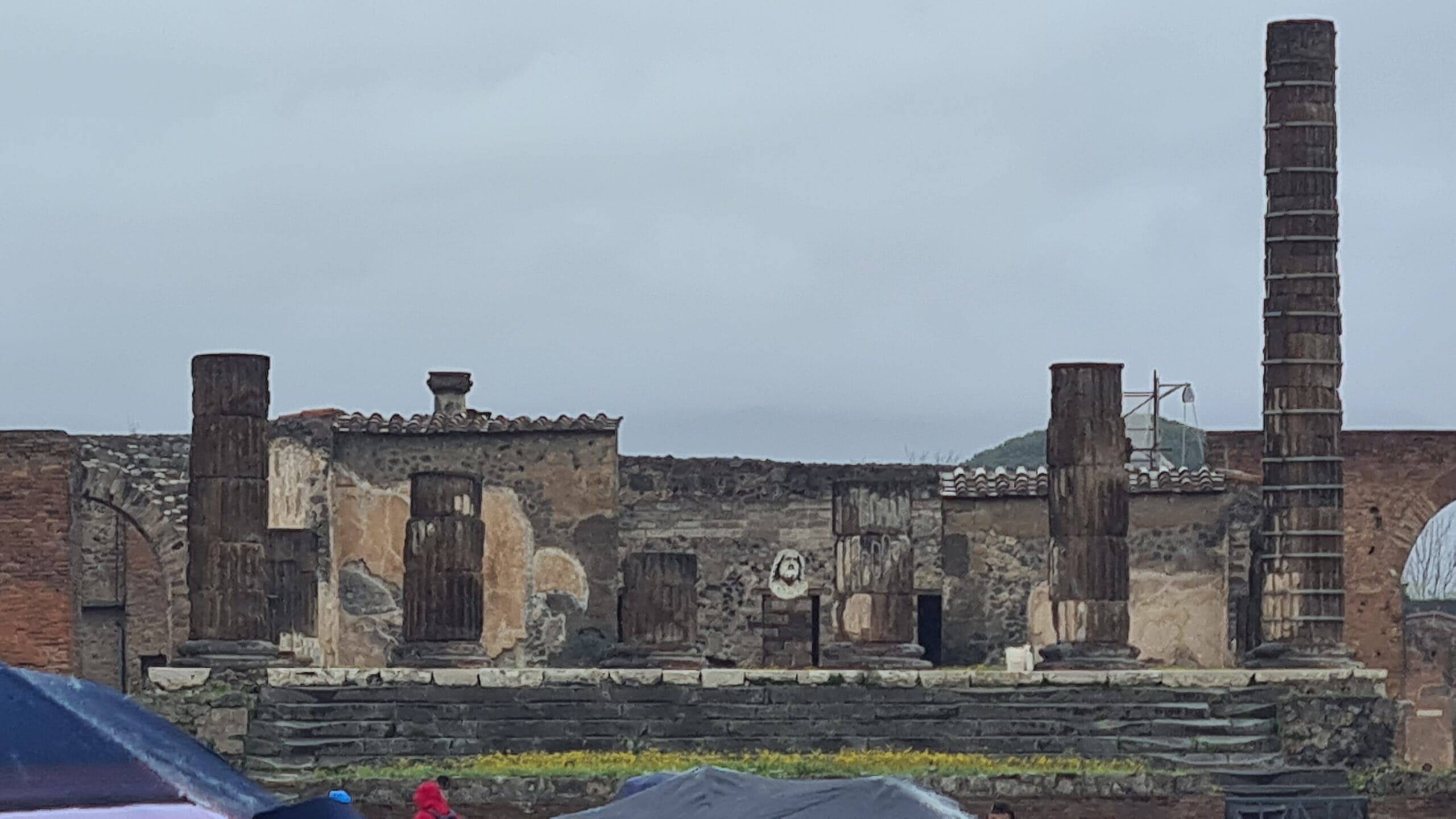
Unfortunately, with not a lot of time to listen we hurried on, past Santuario di Venere (Temple of Venus). The temple of the goddess to whom Silla dedicated the colony in calling it Cornelia Veneria Pompeianorum. The building, made entirely of marble, was situated in the part of the town with the best view out to sea and was clearly visible to ships. It’s a shame that little of the temple now remains as it would surely be a sight to behold.
From the centre of public life, we made our way to the gateway that once connected this bustling city with the sea.
Reaching Porta Marina, it’s easy to imagine the weary legs and determined strides of traders, travellers and townsfolk making their way from the bustling harbour below into the heart of ancient Pompeii. With the Bay of Naples glimmering behind you and the slope steep beneath your feet, this would’ve been no gentle stroll—but it was the city’s main link between the sea and the Forum.
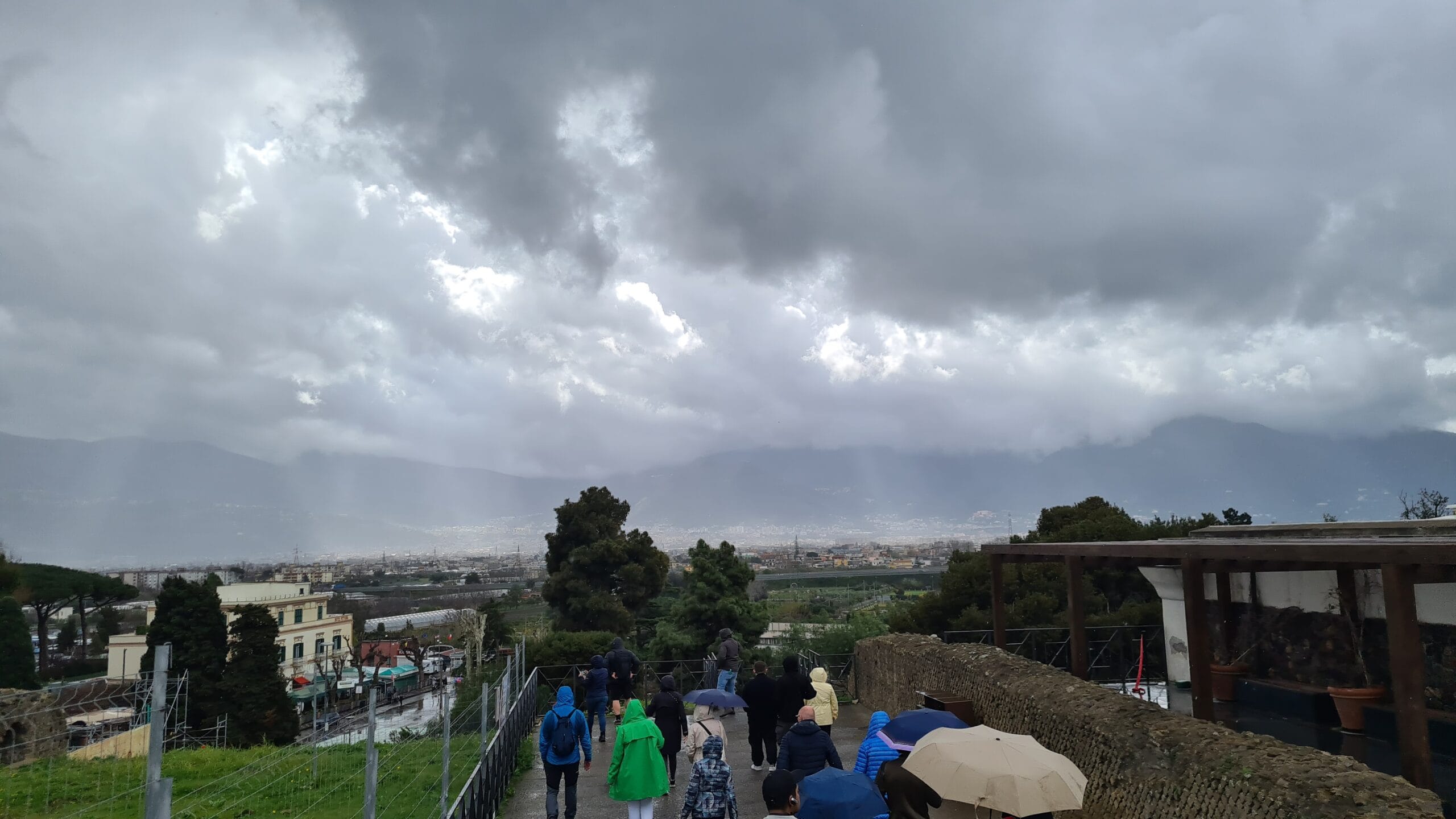
This grand gate was built for both foot traffic and wheels, cleverly designed with two arched passageways: a narrow stairway for pedestrians and a wider, taller arch for carts and wagons. Functional Roman engineering at its finest. The gateway itself forms part of a defensive tower, its barrel-vaulted tunnel leading you onto Via Marina, right beside the Temple of Venus—a suitably dramatic entry point to one of the most iconic cities of the Roman world.
Just inside the city walls and cascading down a hillside lies the Villa Imperiale, a once-luxurious residence built during the early Imperial period. Its terraced layout took full advantage of Pompeii’s natural slope, offering sweeping views over the Gulf of Naples—because if you were part of the Roman elite, of course your living room had sea views.
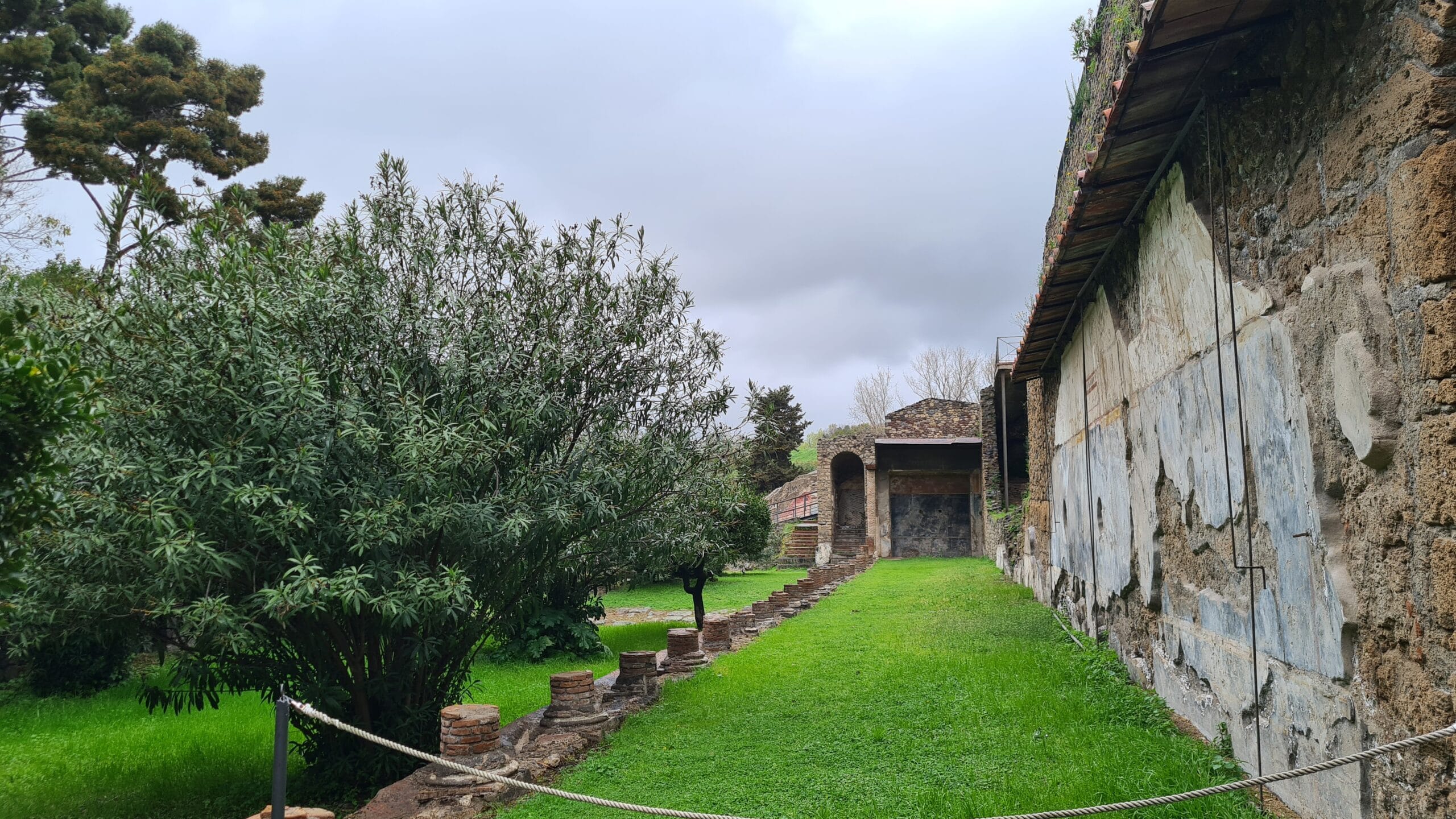
Though badly damaged in the earthquake of AD 62 and never rebuilt, the villa still retains enough grandeur to fire the imagination. The 80-metre-long colonnade, once lined with 43 fluted columns, must have been a striking sight—especially against the rich black wall panels that once backed them.
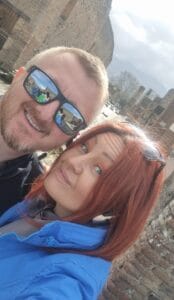 We left Pompeii cold, damp, and a bit shellshocked—not by the weather, but by how alive it still feels. From its bakeries and takeaways to its steamy bathhouses, from tragic stories frozen in ash to comic relief carved into stone, Pompeii is more than a ruin. It’s a mirror held up to the ancient world—cracked, but still sharply reflective.
We left Pompeii cold, damp, and a bit shellshocked—not by the weather, but by how alive it still feels. From its bakeries and takeaways to its steamy bathhouses, from tragic stories frozen in ash to comic relief carved into stone, Pompeii is more than a ruin. It’s a mirror held up to the ancient world—cracked, but still sharply reflective.
Amidst the tragedy, there’s resilience. The city has been partially uncovered, cleaned, mapped, and interpreted by generations of archaeologists. New discoveries are still being made. Tiles, frescoes, entire rooms are regularly brought to light, telling stories we didn’t even know we were missing.
Our tour included lunch halfway up Vesuvius and then a continuation to the summit. By now the clouds had closed in and the weather was not looking good at all, but onwards and upwards we continued.
When booking these tours, quite often the lunches will come with a wine tasting as optional or you can add a wine tasting as we had done previously in Croatia. Today, we were apparently the only lushes in the group, and therefore we were sat away from the rest of the group on our own table for two, with our own waiter.
If you’re into wine and not driving, I recommend always taking the wine option.
The food at Kona was very good. It may have been surpassed by the views, should we have been able to see further than 50 metres into the cloud!
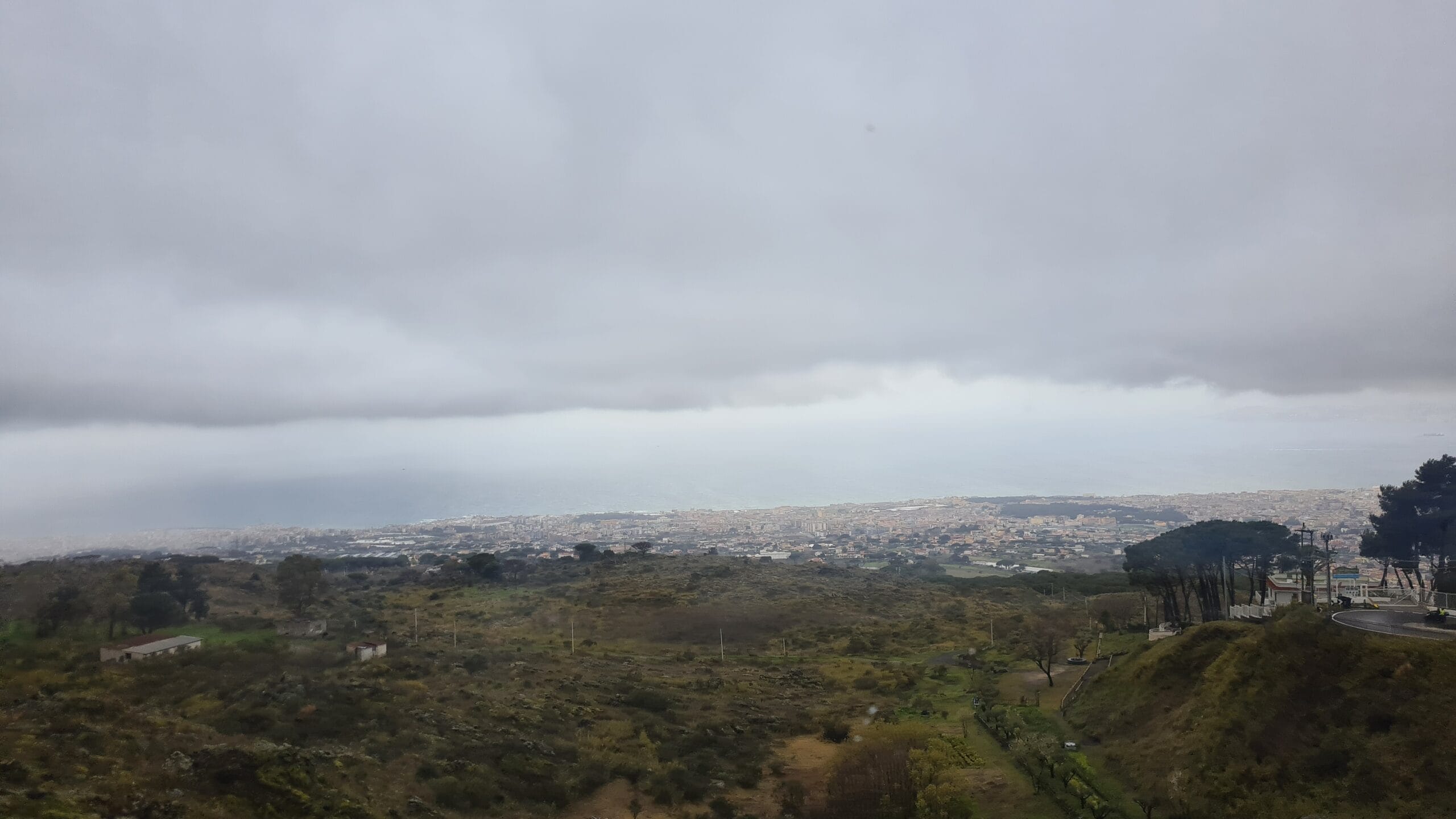
Unfortunately for us the mixed starter of local street food was a plate of fried goodness too far for Zoe, not wanting for us to appear rude by leaving these tasty morsels, I helped the plates look respectful.
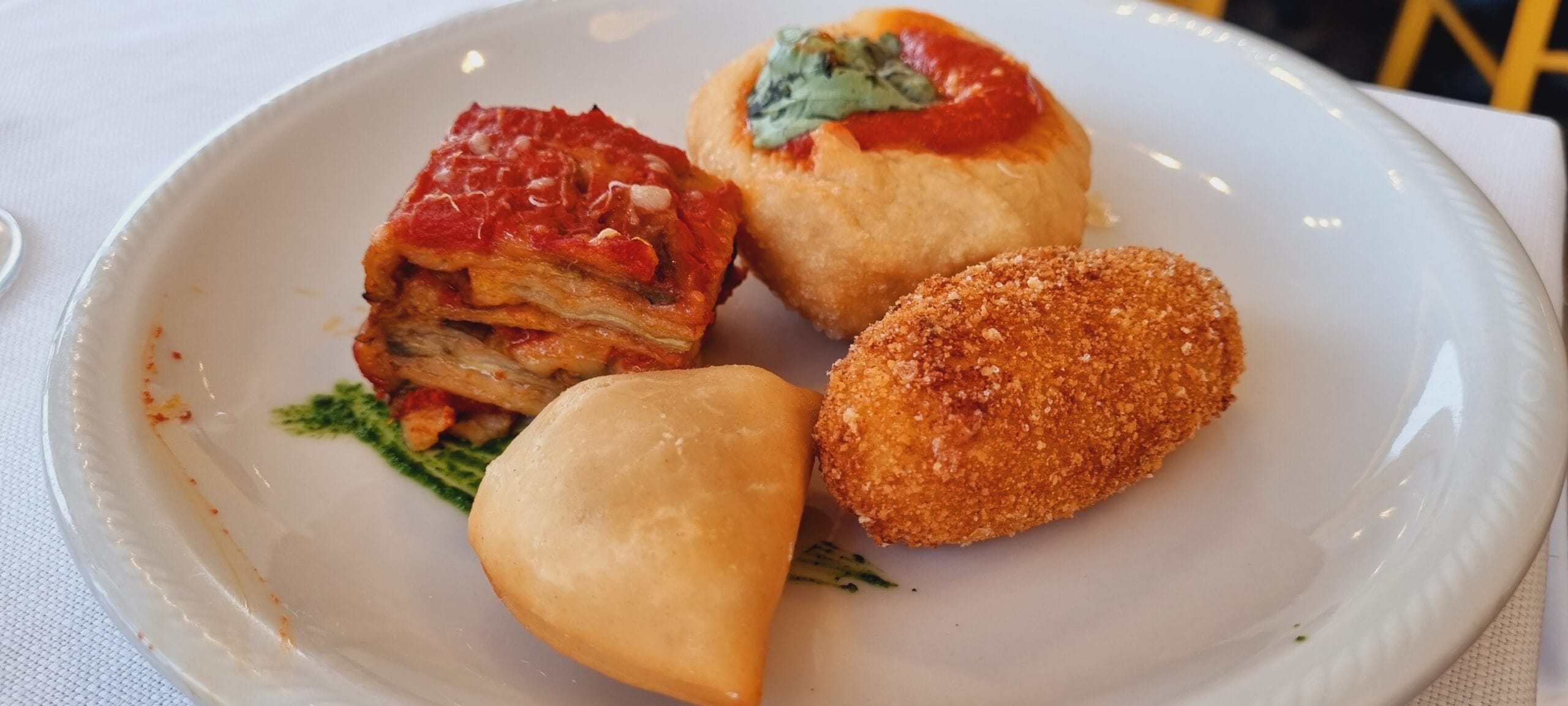
 The service was great, friendly and informative. Each course came with a new wine, all from the Sannino Herculaneum vineyard. Wines from grapes grown in the rich fertile Vesuvian soil. Delicious drops, all of them. In particular, the delicious sparkling red Gragnano is something a bit different and well worth a flutter.
The service was great, friendly and informative. Each course came with a new wine, all from the Sannino Herculaneum vineyard. Wines from grapes grown in the rich fertile Vesuvian soil. Delicious drops, all of them. In particular, the delicious sparkling red Gragnano is something a bit different and well worth a flutter.
Two different pasta dishes followed, one of which stood out. A slow cooked beef ragu with Tropea onion, so rich, yet sweet, unctuous, yet clean. The only problem was that we had to share it! But Zoe, excited to recreate the dish at home, went to find out the chef’s secret recipe. It was ever so simple-great produce, grown in the most fertile of lands and time.
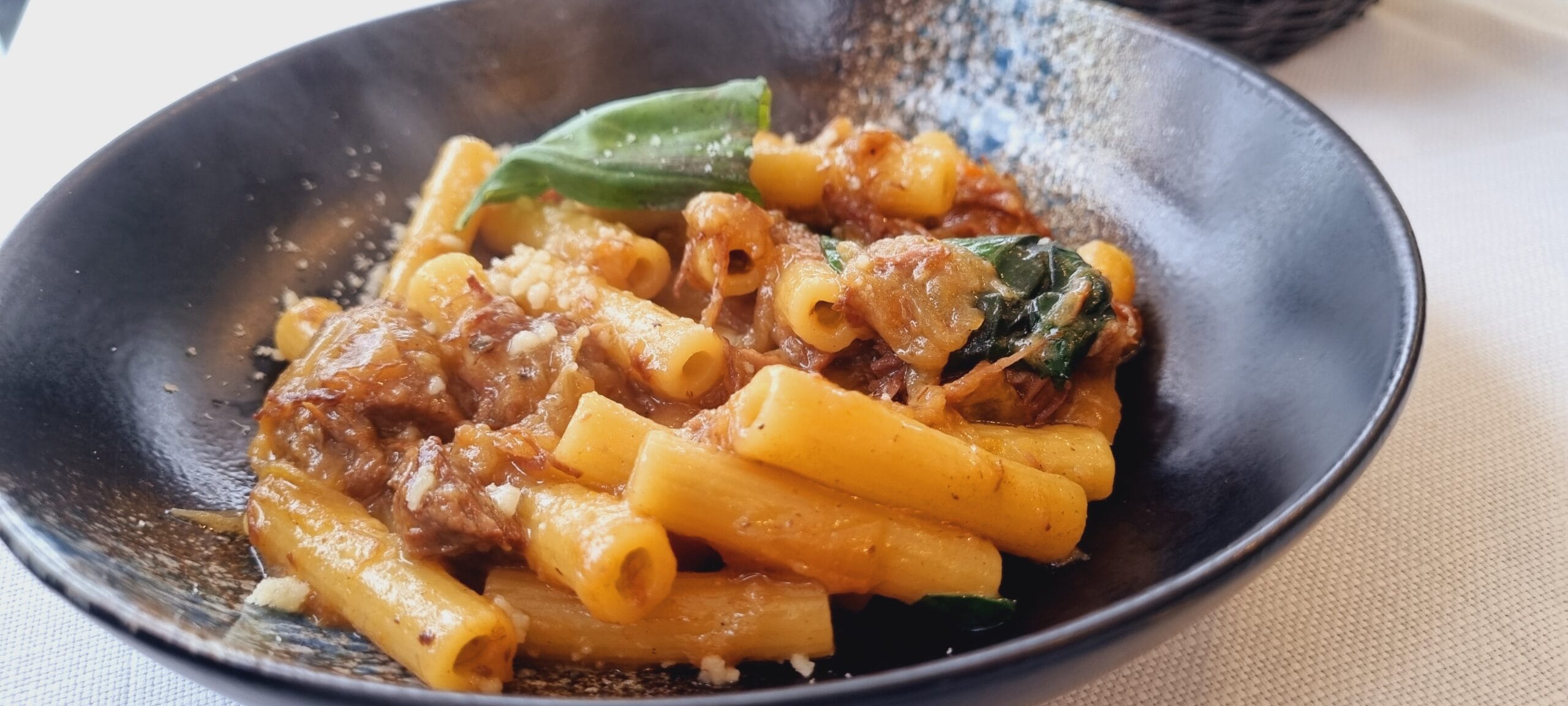
 Our private dining experience, just a few feet from the rest of the party, almost complete, the clouds began to lift and visibility increased to maybe 500 metres, maybe we would be in luck in our continuation to the summit. But before we set off, no Italian meal is complete without a little something sweet, in this case, the classic Tiramisu. Zoe doesn’t like the texture normally, in badly made versions the wet sponge can be cloying. But this was superb, light with a nice kick of coffee and still a little crunch. Perfetto.
Our private dining experience, just a few feet from the rest of the party, almost complete, the clouds began to lift and visibility increased to maybe 500 metres, maybe we would be in luck in our continuation to the summit. But before we set off, no Italian meal is complete without a little something sweet, in this case, the classic Tiramisu. Zoe doesn’t like the texture normally, in badly made versions the wet sponge can be cloying. But this was superb, light with a nice kick of coffee and still a little crunch. Perfetto.
Bellies full and hopeful of a chance to stare into the great crater of Vesuvius our driver optimistically set off up the volcano. Word from a group ahead wasn’t promising, but our guide was keen to go find out for ourselves.
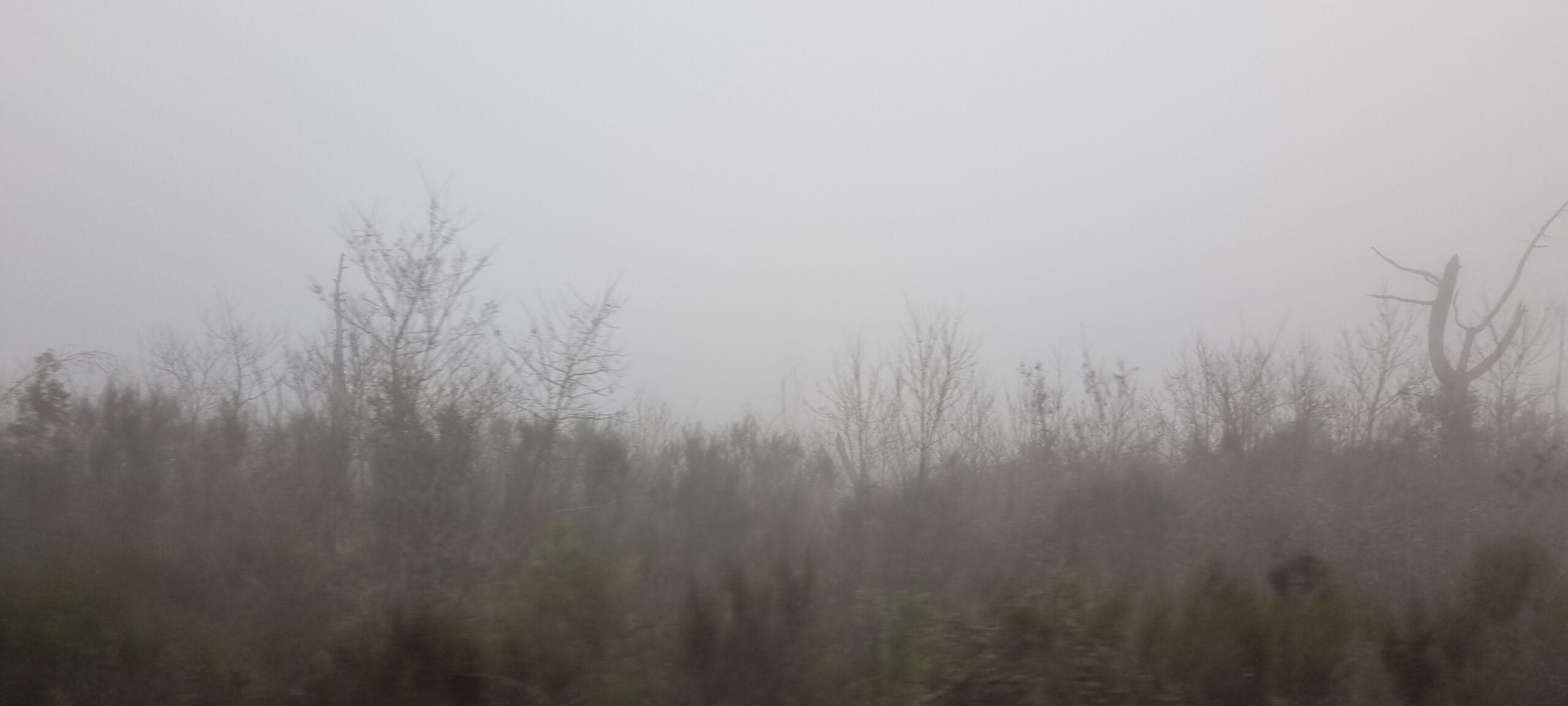
Sure enough, the top was closed until further notice. A few weary tourists in all weather gear stood defiantly next to the entrance, continuing to get battered by the weather. We hunkered down in our heated minibus.
The guide quickly ascertained the group would prefer to return to Naples than sit for a couple of hours waiting for the weather to improve.
She did her best to entertain us on the way back, but I think the full bellies and disappointment made for a tough crowd.
Yes, the weather dampened our visit to Pompeii and Vesuvius. Yes, the Pompeii tour was rushed and Vesuvius visit cut short. And yes, I very nearly made ancient history myself by falling into a 2,000-year-old gutter.
But would I go back? To spend longer exploring frescoes, frozen stories, and the everyday chaos of ancient life? To finally reach the top of that volcano and see what Vesuvius is hiding behind its clouds?
Absolutely.
After all, you can’t speed date a civilisation in two hours—but you can fall for it.
Follow us on instagram @a2z.wander

A2Z Wander | Our Blog A Rainy Arrival (and a Slight Hangover)Lamezia Terme almost didn’t get its own blog post. There’s only so many ways
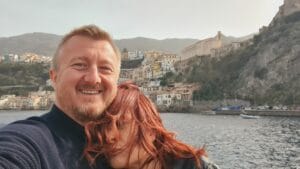
A2Z Wander | Our Blog A short coastal train ride punctuated by dramatic thunderclaps brought us further down into Calabria to a town called Scilla.
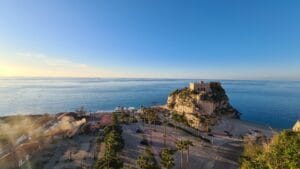
A2Z Wander | Our Blog This is quite the introduction to the town of Tropea… This is the view from Belvedere Piazza del Cannone in
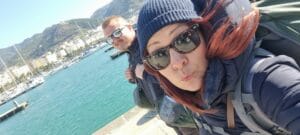
A2Z Wander | Our Blog Three weeks into the trip, and we were finally swapping wheels for waves, boarding our first boat along the coast

A2Z Wander | Our Blog With Sorrento in our rear-view mirror and the sea glittering to our right, we eased into the Amalfi Coast Drive,

A2Z Wander | Our Blog Naples left its indelible mark on us. We were sad to be leaving with so much still unexplored. But, if